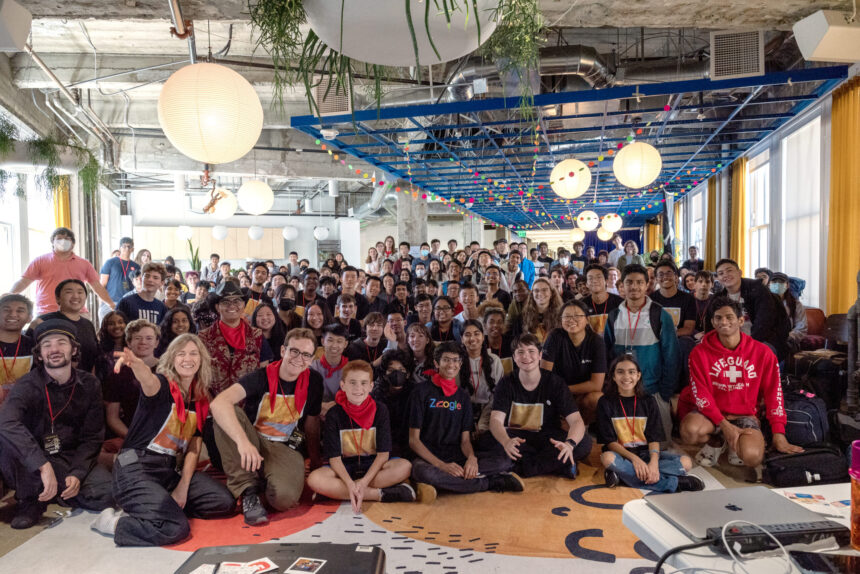I grew up without electricity, Wi-Fi or running water. I lost my mother when I was 16 and had no traditional education. But now, at 19, I’ve been able to create something amazing with other young people, some from poverty and some from privileged backgrounds, banding together to prove that community is what matters most. I got into technology out of necessity. The world is full of technological problems, and even “small” problems are very real for those who experience them. We lived in Nassau, Bahamas, and it was hot, and I needed a fan for my grandmother. The problem was that we didn’t have electricity. So I went to the library to research, and realized that I could use a small solar panel and an Arduino microcontroller to power the blades of an old fan I found. My chess teacher was kind enough to give me the money I needed, and the problem was soon solved. This experience taught me that I can sit in the heat and be miserable, or I can go and look for a solution, and that when I’m working, people often lend me a hand along the way.
When I was 17, I received a grant to attend a hackathon in San Francisco run by a group called Hack Club. This is their story, my story, and the stories of the other teenage Hack Club members that we’re creating together.
Global Teen Hacker Club
Hack Club was founded in 2014 by Zach Latta, a teenage programmer who dropped out of high school. Zach struggled in a public high school that didn’t offer a meaningful computer science program. He was looking for friends who liked computers, and at age 16, he decided to create a community for other young makers and leaders. His efforts earned him a Thiel Fellowship and $100,000 to realize his vision: a place where bright young people interested in technology could collaborate and build faster by building together. Later, Zach joined co-founder Christina Asquith, a journalist and war correspondent who had founded The Fuller Project, a journalism nonprofit focused on issues affecting women and girls around the world. Together, the two built Hack Club into a global nonprofit program that included all teenagers regardless of gender or economic background, with the goal of bringing together hundreds of thousands of young people who love building and creating projects using technology, art, and creativity. And it worked. I’m no longer alone writing code on my phone, and my social network and comfort zone are much larger than they used to be. And I’m not the only one.
Riding the Wave
Chris Walker had a typical experience in high school math class, playing with a TI-84 graphing calculator to kill time. But this gave him an idea: to make a game where ghosts sled through graphs against a backdrop of beautiful artwork to make abstract math problems more engaging. Chris had been working on SineRider for years but never made it across the finish line. But when he joined Hack Club, a team of more than 20 teenagers from around the world spent nights and weekends polishing his creation. One of those contributing coders was Irene Rivera. The pandemic era was lonely for her, like most students whose social lives were suddenly turned upside down. She was curious, but without a community, in her words, “I didn’t really know how to solve problems or improve my projects. I didn’t have any real resources at school, and no one to ask questions. Now my best friend works with me… we can make progress together, share ideas, and feel less isolated.” The appeal of SineRider was obvious, she says. “This game brought art and real fun to math, which was very unique. And what’s great is that it was made by young people for other young people.” Their efforts have paid off. SineRider is played daily by thousands of students around the world to improve their understanding of functions, and Eileen is working on developing a translation system so students can play in their own language. And with the support of the Hack Club, she’s started her own hackathon in her hometown of San Antonio, Texas, where she’s working on developing AI educational tools while studying biomechatronics.
Made by train
“This can’t happen. There’s no way a nonprofit would send 42 people across the country to build something on a train,” said Ian Madden, who was in eighth grade when he began making this statement. Zephyr Hackathona 3,502 mile train journey from Hack Club HQ in Vermont through New York, Chicago and the Rocky Mountains to Los Angeles, California. One of his first projects was fixing an out-of-control database issue in a massive hackathon ticket and scrapbook tool. He learned a lot from this task, not just about the technical aspects but also about logistics, while sitting in an airport on his way to the hackathon. Since then, most of Ian’s work has been helping to build the unique infrastructure that supports both the club’s in-person events and the passion projects of hundreds of club fans. These tools include Hackathon.zip, an all-in-one platform for hosting hackathons, Hack Club Bank. The latter encourages club members to keep their projects on track by providing them with bank accounts and a transparent ledger so funders can see where all the money is being spent. Ian still has a few years before he enrolls in college, where he plans to major in computer science. But he feels better prepared: “I feel like I’m more prepared, not just technically, but professionally.”
Braving the Fire
Kevin Yang loves to make things. It doesn’t really matter what you make. At 17, he and a friend built a flamethrower out of a taser, sunscreen, and a toy guitar. In true hacker fashion, they had no access to common electronics in the woods, so they improvised with the remains of an old RC car and other scavenged items to make a fire. Kevin started building circuit boards in middle school, with mixed results. “It was a very lonely, intense, and difficult adventure. It was expensive, I didn’t know what I was doing, and I had no one to talk to.” To solve this problem, Kevin teamed up with Max Wofford, an engineer at Hack Club, to on boardis a grant program that empowers teenagers to design their own circuit boards, and he’s now working on building out the program’s tutorials to ensure students have all the resources, guidance, and support they could have hoped for.
Ships and manufacturers
As Hack Club grew, it became necessary to create educational materials for teens who couldn’t attend their local club. Hack Club engineer, makerspace wizard, and creator of the Gram drawing language, Leo McElory, worked with Cedric Hutchings, a talented programmer hired straight out of Appalachian High School, to design Hack Club’s first “You Ship, We Ship” project. Twig — is a web-based editor that teenagers can use to draw pictures, make music, and create their own tile-based games. Once club participants publish and “ship” their creations online, Hack Club mails them the materials for a miniature console to install them on: a Sprig kit that mounts two D-pads, an audio controller, and a 160×128 color LCD to a Raspberry Pi Pico. Lucas Honda, a 15-year-old from São Paulo, Brazil, joined Hack Club in 2022. One of the first projects he set himself was to build and upload Flurffy, a JavaScript-based Sprig game reminiscent of the original Flappy Bird. But for him, the biggest reward is not just the positive reviews from his new friends: it’s establishing himself in a community where he can help other young people build their own games.
Art is mathematics
Bright Lee, a ninth-grader from Southern California, was born to software engineer parents who encouraged his tinkering, taking apart old cell phones to examine their circuits and reverse engineering how touch technology worked. Bright is also a contributor to another Hack Club beta project, “You Ship, We Ship.” Blotis a project that brings digital art into the real world. Club members write programs to create works of art using a custom web editor, and Hack Club will send out CNC machine kits to draw them. Bright is currently working on adding animation features to the editor and developing a music engine.
Everyone is great
Zoya Hussain is originally from Dallas, Texas. Her father, who emigrated to the US from Pakistan, told her a lot about computers during her childhood and helped her take apart robots to understand the engineering and design inside. She was instantly hooked. Although she was already familiar with hackathons (she had won four in a row), she felt something special about the hackathons organized by Hack Club. “I had never seen a team invested in such collaboration, with a focus on creating a magical event. I learned about how the event should cater to its audience and how to do that in practice.” This is especially important for girls. STEM is still only about 20% female, and to change this, start by practicing inclusion. This is what led Zoya to hackathons. Hack Club Service Projectshosts one-day hacking events to not only get girls interested in coding, but also to connect them to a community where they can get support without feeling like an imposter. Alongside other engineering projects, Zoya is now able to help more girls share their insights. “A world has opened up before me that I never even knew existed. Before, I wasn’t sure if anything related to computer engineering was for me. Now I’m sure.”
So how can you get involved? Teens can join the Hack Club online community today. SourceAdults, please consider making a donation to support our programs. hackclub.com/charity!







